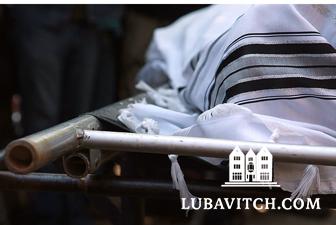In response to readers who have inquired about the practices of Jewish burial, Lubavitch.com brings you this excerpt from a Wellsprings article, Ancient Trades.
These are the precepts for which one reaps benefit in this world, and eternal reward in the world to come . . . burial of the dead.—Mishna Peah 1:1
The glamour of Jewish professions are predictably with the pulpit rabbi and the cantor, whose skills may reward them with generous salaries, prestige and recognition. On the order of necessity, however, these rank far below the discrete, obscure functions that happen behind the scenes, day after day, for the maintenance of a Jewish community.
The people filling these roles are ushers of sorts, readying the living to create life, and alternately, escorting the deceased on their passage to the afterlife.
Brocha Levertov is just such an usher. By night, she is the mikvah attendant at the Crown Heights women’s mikvah. By day, Brocha is on call to perform taharot. A member of the women’s Chevra Kadisha, the Jewish burial society, Brocha participates in that final act of benevolence for the departed soul of a woman no longer able to prepare her own body for its journey to the afterlife.
Brocha is part of a threesome needed to cleanse and dress the body before it can be laid to rest. While washing the body and taking great care to preserve its dignity, one of the women will recite the 13 Divine attributes of mercy. “What we do,” says Brocha matter-of-factly, “is symbolic of washing away the person’s sins. As we do this, we ask that G-d be merciful to this woman, who is now on her way to Divine judgment.
The work of the Chevra Kadisha begins the moment they are informed that a Jew has passed away. A member of the society will be dispatched to begin a vigil over the body, both as a sign of respect for the deceased, and to prevent medical or other authorities from performing an autopsy—in Jewish tradition, an offense to the departed. The body is prepared and dressed according to very specific instructions carried out solemnly, to the recitation of verses from Scripture extolling the beauty and sanctity of the human form.
"We believe that the individual still retains a certain level of consciousness and hearing, so we maintain a real focus on what we are doing,” says Brocha. A manual distributed to members of the Chevra Kadisha puts strong emphasis on respect for the body of the deceased. “The body is regarded as holy for it housed the soul,” explains the manual.
Before dressing the body, three large buckets of water are gently poured over it, and it is then immersed in the Mikvah, while Brocha and her partners pronounce the words, “tehorah hi” meaning, she is pure. The body is then dressed in white linen shrouds, all of which are sewn by hand, without any knots. There are no pockets, for as Brocha plainly says, “The person takes nothing but his actions with him . . . “ The ties are undone easily, says Brocha, “so that when Moshiach comes, the resurrected will easily remove the shrouds.”
The various articles of linen correspond to the garments of the kohen, the Temple's high priest. The head-covering for a woman is likened to a bride’s veil—for as the High Priest did in the Temple, and as a bride stands under the canopy, so too, the soul is on her way to stand before G-d.
The simplicity of the shrouds (a male body is wrapped in a talit in addition to the shrouds), the absence of all adornments, and the use of a plain wooden casket (in Israel, the body is laid directly on the ground, with no casket at all) are harmonious with the course of the body’s natural disintegration. Anything more—a fancy, sealed coffin, cosmetics, clothing or other embellishments hamper the body’s return to its organic origins and thus frustrate the soul’s ascent to its source.
Brocha regards her occupations with a wholesomeness at once earthy and spiritual.
“In life as in death, water washes off the past, the sins; it has the spiritually cleansing effect, and takes the person to a higher spiritual level. The work of the Chevra Kadisha helps do the same for the dead person, whose neshama is now ascending to a much greater spiritual place, and ultimately, to techiyat hameitim, to resurection of the dead.
Neither Brocha nor the other members of the Chevra Kadisha take remuneration for their services.
“This is meant to be a chesed shel emet, a true kindness, one for which the beneficiary cannot give thanks. Still, the sages promise that the quiet efforts of the Chevra Kadisha will be rewarded both in this world and in the world to come.

Be the first to write a comment.